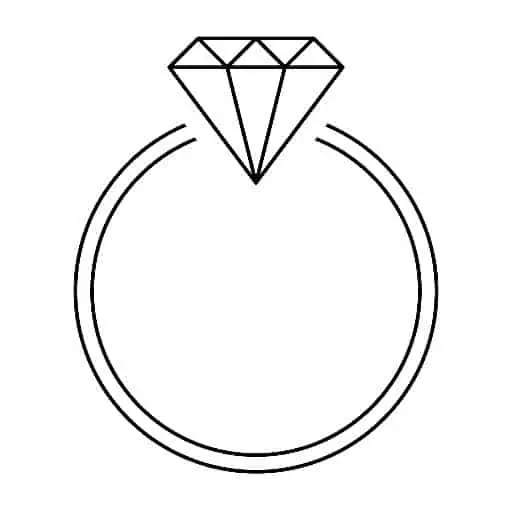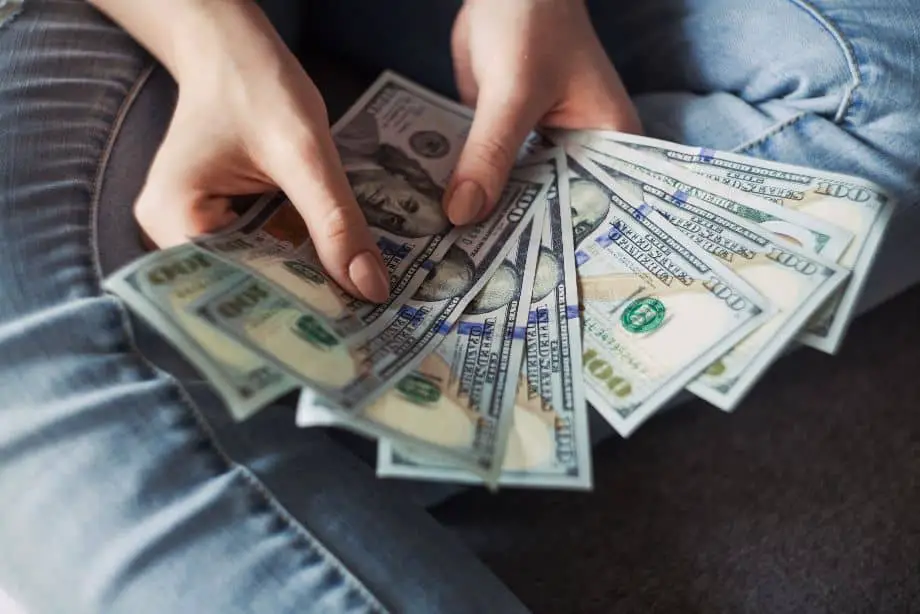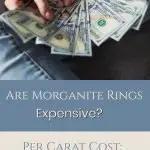Thinking of buying a Morganite ring? Morganite is gorgeous and distinctive, but can you afford it?
Are Morganite rings expensive? Morganite costs roughly $300 for a one-carat stone, however quality characteristics regarding color, cut, and clarity will influence the cost of individual stones. Size will also influence the cost of a given stone, but not to the same degree you would find with diamonds or other gems.
There are a number of factors that contribute to the cost of Morganite rings. I’ll address the key influencers of cost below.
What is Morganite?
Before diving into cost drivers, it might be useful to quickly explain what Morganite is, and where it came from. Morganite comes from the Beryl family. Emerald and Aquamarine are two other well-known Beryls. Morganite gets its beautiful range of pink tones from traces amounts of manganese.
In 1902, George Kunz discovered a stone that had color shades ranging from pink to purple, which he called Kunzite. In 1910, he discovered a new stone in Madagascar, with hues ranging from pink to peach, he decided to name it after someone else. George was good friends with J.P. Morgan, the banking tycoon, and enthusiastic gem collector. He delighted Mr. Morgan by naming his new discovery Morganite.
Morganite Supply and Demand
Stones can get quite expensive when there is strong demand for a particular type, but very limited supply. Diamonds are a good example of this. If they could easily find them in your yard, for example, they wouldn’t be coveted or valuable. It’s scarcity that makes us willing to shell out large sums of money for them.
In the case of diamonds, that scarcity is carefully orchestrated and controlled by dominant players in the diamond industry. It’s the sense of rarity and exclusivity, coupled with persuasive marketing messages, that fuels the sale of diamonds at incredibly high prices!
If the market were suddenly flooded with a supply of diamonds that far outpaced demand, prices would plummet and demand would begin to dry up. We would no longer crave diamonds if they didn’t provide us with a sense of exclusivity, and we certainly wouldn’t be willing to pay much for them if they were common.
Recognizing all that, diamond cartels carefully regulate the diamond supply to give the false appearance of scarcity. It works—even small stones can cost thousands of dollars!
Morganite isn’t controlled by a cartel of any kind. It’s essentially provided to the market as it’s mined, cut, and polished.
Morganite demand is strong, and seems to be getting stronger! One popular wedding site conducted a huge survey a couple of years ago. They found that Morganite was one of the most popular non-diamond center stones for engagement rings. Moissanite and Sapphire were also at the top of the list.
Morganite is only mined in a handful of countries. It’s primarily mined in Brazil and Madagascar. Less significant discoveries have also been made in places like China, Russia, Afghanistan, a couple of spots in the US, and few places on the African continent.
The price of Morganite could easily climb much higher in future years as demand continues to increase and some of the limited mines that exist get tapped out. If those scenarios play out, the GENUINE supply and demand imbalance could make Morganite MUCH more expensive.
Be careful when buying Morganite jewelry—especially as prices climb in the future due to the rarity of Morganite. There are always fake stones floating around that are made of glass or other materials. It’s a good idea to verify the authenticity of what you’re buying with a certificate from a trusted gemological institute where possible.
Morganite Price Per Carat
Morganite is one of those stones that you may want to consider if you want something a little different than what others are wearing. It’s also a stone that some turn to when they want a colored gemstone for their ring but can’t afford to go with a colored diamond.
Morganite price per ct. is approximately $300, however, there are a couple of caveats
- Value doesn’t always scale with size. Morganite is frequently found in larger fragments, so unlike diamonds and other similar gems, the value of Morganite doesn’t climb exponentially as stones get larger. In other words, a two carat stone will cost you more than a one-carat stone, but not MUCH more—and certainly not twice as much!
- Color is king. As mentioned earlier, the price of a particular stone is closely associated with the aesthetic characteristics of the stone (things like color, clarity, and cut). Of those visual elements, color is the most important cost driver! A small Morganite stone with vibrant pink color on a small Morganite stone, could be many times as much as a three-carat stone with pail (weak) coloring for example.
- Natural coloring adds value. Untreated stones are much more valuable than treated, or ‘enhanced’ stones. Here again, a small untreated stone with great coloring will be far more valuable than a much larger stone (with even more vibrant color) that has had its coloring enhanced.
In light of all that, you’ll sometimes find a one-carat Morganite stone for far less than $300. That sometimes happens when the stone has less desirable coloring or visible inclusions. Those stones may still work well for some rings.
On the flip-side, you can also find one carat Morganite stones that cost thousands of dollars, because they have unusual characteristics that make them far more rare.
A comparison is often helpful. If you look at Morganite price vs diamond pricing for a similar one-carat stone, white (or colorless) diamonds cost about 10 times as much. Colored diamonds (which are a better side-by-side comparison in some respects) cost a great deal MORE. While a one-carat Morganite stone costs approximately $300, a reasonably colorless diamond of similar size will typically run $3,000 to $5,000.
Morganite Value vs Diamond
We’ve already compared the cost of Morganite and Diamond, but what about the value comparison between the two?
We know that Morganite is much less expensive, but can the higher cost of Diamonds be justified? It’s a polarizing question. You can easily find people that will passionately argue their perspective on both sides. Your opinion matters most when it comes to your ring, but I’ll give you a few issues to consider.
We all use different factors to measure value. Value isn’t ONLY related to what you pay—it’s about what you get for what you pay. Based on that, the cheapest option ISN’T always the one that offers the best value.
To illustrate, think about buying jeans. Imagine buying the 3 pairs described below.
- You find a pair of jeans on a clearance rack for $5. They don’t fit quite right, but hey, they’re 5 bucks…and you can’t pass that up! You figure that once the material relaxes a bit, they should work fine. You never wore these jeans out of the house. After putting them on once or twice, you decided that you don’t like them at all. The fit just isn’t right, and you don’t really love the look either. You eventually donate the jeans to Goodwill.
- A month later, you come across another pair of jeans that you like. You flip the tag and find that they cost $35. The material seems durable, they fit well, and you really like the look of them. You make the purchase, and are glad you did. They’re one of your favorite pairs—very comfortable. The jeans last you for 9years, before you have to replace them.
- After a movie at the mall, you walk through a store and find a pair of name brand jeans that look really nice. The cost of the jean seems like a misprint. Who would drop $300 on a pair of jeans? They look nice, fit well, and you’d love to be seen wearing that name brand. You swallow hard, buy them, wear them frequently. You continue to love the look and feel of the jeans. They last for 10 years.
It’s obvious which pair of jeans was cheapest—but which one represented the best VALUE? Most people would agree it’s NOT the first pair. Both the 2nd and 3rd pair were worn regularly and lasted a long time.
From my own perspective, the second pair was the best value, because of the combination of price and utility (usefulness). Those jeans lasted NINE YEARS! When you do the simple math, you find that she essentially paid $3.89 per year to own and wear those jeans.
The third pair lasted 10 years, so she ended up paying $30 per year for the life she got out of them. They were more durable, but from a dollars and cents perspective, the little bit of extra life they provided wasn’t worth their substantially higher price. The one unique value they did bring is a boost of self-esteem that came from wearing the popular label. Was that worth the added cost? That’s one of those questions people will have different opinions on.
Ok, so what does the example have to do with diamonds and Morganite? I’m sure you already get it, but Morganite probably most closely resembles the second set of jeans. It’s more reasonably priced, and provides lots of beauty and utility! We aren’t talking drab by any means! You’ll likely draw lots of compliments when you wear your Morganite ring.
Diamonds are very much like the 3rd pair of jeans. Some people choose this option because they feel a sense of social pressure, and feel a strong desire to conform—others may just love the look of the stone. Regardless, diamonds carry a message about social status. It’s very important to some people that their center stone be big enough to send the silent message that they’re successful. Diamonds are beautiful and will last a long time, but are they worth the added cost? Here again, different people will have differing opinions.
Why is Morganite so Inexpensive?
Rarity combined with popularity is a recipe for high prices. Diamonds are thought of as rare, but in reality, their rarity is an orchestrated illusion. Oil cartels drive the price of oil up by restricting supply. The diamond industry regulates supply in a similar way. They don’t release all that they mine—they very carefully restrict supply to prop up the high prices that give diamonds the feeling of exclusivity that makes people want them.
Morganite is a rare stone that’s found in very few places, but it isn’t consolidated, controlled and manipulated the way that diamonds have been for many decades now. That’s a huge aspect of why Morganite is so much less expensive than diamonds today.
Another key distinction: Morganite doesn’t have the well organized, and heavily funded, marketing messages that diamonds have long enjoyed, to provide awareness, shape our opinions, and fuel demand.
It’s hard to organize, and fund, a consistent and effective advertising blitz unless you have a monopoly in the market (like we’ve seen in the diamond industry for so long).
Key Drivers of Morganite Value
I mentioned earlier that for Morganite, as with most gems, color is king—it’s the most important criteria. The most sought after color for Morganite is pink. Pinks that have a darker, almost reddish hue to them are also desirable. Morganite that has more of a peach or orange hue is much less valuable.
Another important consideration of value is clarity. Morganite is generally ‘eye clean,’ meaning that you can’t see obvious inclusions with the unassisted eye (without magnification) in most cases. What’s even better is a ‘Clean’ stone, where inclusions are present in the stone at all. The more visible and obstructive inclusions are in a particular stone, the less it’s worth.
‘Treated’ or ‘enhanced’ stones undergo a heating process that reduces the orange and peach tones in the stone, making the pink tones more dominant.
Most Morganite on the market today HAS been heat treated to improve color. That’s nothing to be concerned about, but it’s something you should be aware of. The resulting color change is considered permanent. Treated stones sell better than non-treated stones with undesirable color qualities.
“Heat treatment is not detectable, does not fade, and does not hurt the beauty or value of the gem.” -Laurie Sarah
While heat treading doesn’t decrease a stone’s value, untreated stones with good color qualities are often MUCH MORE valuable because they’re far more rare.
Does Morganite Increase in Value?
It’s unlikely that Morganite will increase in value for years. You’ll lose money on nearly all rings if you resell them shortly after buying them. You’ll still typically lose money if you wait decades before selling most rings (once you adjust for inflation).
Because of growing demand, and the prospect of falling supply in the years to come, it’s possible that the value of Morganite may start to climb (possibly substantially). It’s hard to know just how much the price may go up, or how soon, because of all the variables involved.
Morganite Resale Value
Many people buy diamonds with the false belief that they’re some sort of investment vehicle that appreciates with time. This misguided notion is something that the diamond industry benefits from and even fosters through some of their advertising over time that doesn’t offer full disclosure.
Here’s the fact, diamonds are a TERRIBLE ‘investment.’ In fact, diamonds AREN’T investments—they’re consumables.
Consider this, what happens if you buy a big-screen television and then try to sell it used three months later? Can you sell it? Absolutely, if it’s in good condition and the price is right. Is anyone going to give you what you paid for it? Nope! The same is absolutely true of diamond rings.
Those that don’t believe me may have to learn the hard way, but I promise this is true. If you buy a diamond engagement ring and then try to resell it (even years later), you’re likely to be ‘taken to the cleaners.’ I’m not exaggerating!
In fact, I wrote another article where I summarized research I did around the resale value, and average losses, for used diamond rings. I was careful about the listings that I evaluated. They had to reference the original purchase price—most had pictures of their original receipts to show as evidence. You may find the article interesting.
Here’s the scoop, you’re going to lose 30% to 70% of what you paid for your diamond ring when you resell it. Are there people that would be interested in a used Morganite ring? Absolutely, but you’re also going to have to resell that ring at a discount. The question, when you compare the resale value for Morganite and Diamonds, is which one will you lose more money on?
The math is EASY, you’ll lose more reselling the diamond. That’s true because you paid a lot more for it. The article that I mentioned above will break down the math for you so you can see how things shake out when you compare the resale of a diamond and more frugal ring choice.
In Summary
The term ‘expensive’ is relative. Morganite certainly brings strong value, and is much less expensive than many alternative gems. Since it’s a fairly hard stone, and has an interesting look, it’s a ring that’s growing in popularity. It’s also a stone with actual rarity, that is likely to get more rare and expensive in the future.
Related Posts:


